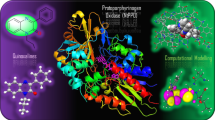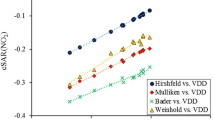Abstract
The redox properties of 1,4-dioxides of hydroxymethyl and formyl derivatives of quinoxaline were studied by means of EPR spectroscopy and polarography. The electrochemical reduction of the 1,4-dioxides proceeds in several steps with successive deoxidation and the formation of dianions of substituted quinoxalines and is also accompanied by an intramolecular redox process. The experimentally observed hfs constants in the EPR spectra of the anion radicals formed in the reduction are in agreement with the corresponding values calculated by the INDO method.
Similar content being viewed by others
Literature cited
V. M. Kazakova, O. G. Sokol, G. G. Dvoryantseva, I. S. Musatova, and A. S. Elina, Khim. Geterotsikl. Soedin., No. 3, 376 (1980).
A. S. Elina and E. N. Padeiskaya, in: Proceedings of the S. Ordzhonikidze All-Union Scientific-Research Institute of Pharmaceutical Chemistry [in Russian], Vol. 2, Moscow (1971), p. 197.
E. N. Padeiskaya, in: New Chemotherapeutic Preparations for the Treatment of Patients with Infectious Diseases [in Russian], Moscow (1976), p. 89.
W. S. Chilton and A. K. Butler, J. Org. Chem., 32, 1270 (1967).
A. S. Elina, L. G. Tsyrul'nikova, and G. P. Syrova, Khim. Geterotsikl. Soedin., No. 1, 149 (1969).
J. Dirlam and J. W. McFarland, J. Org. Chem., 42, 1360 (1977).
J. A. Pople, D. L. Beverige, and P. A. Dobosh, J. Chem. Phys., 47, 2026 (1967).
V. M. Kazakova, N. E. Minina, I. G. Makarov, and V. B. Piskov, Zh. Struk. Khim., 17, 615 (1976).
E. F. Moriconi and A. J. Pritsch, J. Org. Chem., 30, 1542 (1965).
A. S. Elina and O. Yu. Magidson, Zh. Obshch. Khim., 25, 161 (1955).
A. S. Elina, R. M. Titkova, L. G. Tsyrul'nikova, and T. Ya. Filipenko, Khim.-farm. Zh., No. 1, 44 (1976).
I. S. Musatova, A. S. Elina, O. S. Anisimova, E. N. Padeiskaya, and N. A. Novitskaya, Khim.-farm. Zh., No. 6, 42 (1979).
Author information
Authors and Affiliations
Additional information
See [1] for communication 1.
Translated from Khimiya Geterotsiklicheskikh Soedinenii, No. 10, pp. 1412–1416, October, 1985.
The authors thank I. A. Abronin for his assistance in performing the quantum-chemical calculations.
Rights and permissions
About this article
Cite this article
Kazakova, V.M., Sokol, O.G., Dvoryantseva, G.G. et al. Quinoxaline N-oxide ion radicals. 2. Structures of anion radicals of N-oxides of hydroxymethyl derivatives of quinoxaline and products of their electrochemical reduction. Chem Heterocycl Compd 21, 1164–1168 (1985). https://doi.org/10.1007/BF00515262
Received:
Issue Date:
DOI: https://doi.org/10.1007/BF00515262




